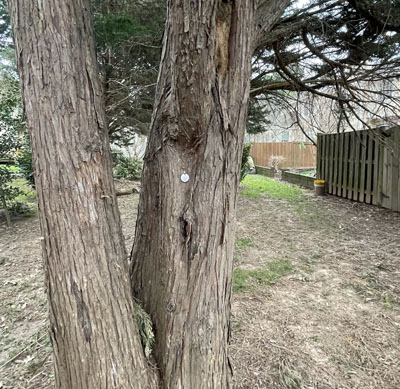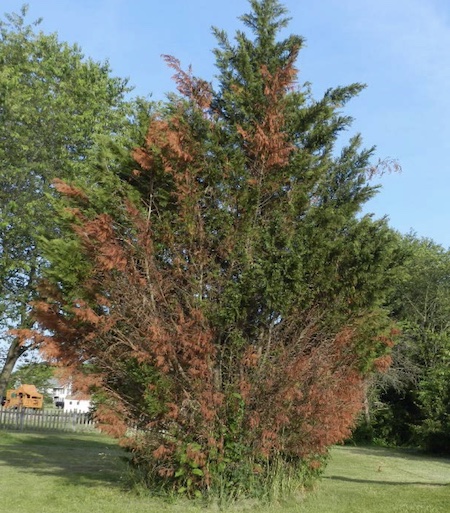Leyland Cypress: A Misunderstood Evergreen
by Pat Dickey, Fairfax Master Gardener
 Leyland Cypress is an evergreen conifer tree that gained popularity in the 1980s and 1990s. It became extremely popular for use as a hedge in suburban areas and because of its quick growth habit. Townhouses and homes with small lawns were being built during this time, and the Leyland Cypress, in this frenzy for privacy, became overused and then unable to be controlled. They are still struggling to survive in many home landscapes. In my townhouse neighborhood in Reston, VA, many have become an eyesore and expensive to keep pruned or removed as they die from fungus and root rot. This is a warning to homeowners purchasing plant material for the new year to stay away from Leyland Cypress and to consider the many other options available.
Leyland Cypress is an evergreen conifer tree that gained popularity in the 1980s and 1990s. It became extremely popular for use as a hedge in suburban areas and because of its quick growth habit. Townhouses and homes with small lawns were being built during this time, and the Leyland Cypress, in this frenzy for privacy, became overused and then unable to be controlled. They are still struggling to survive in many home landscapes. In my townhouse neighborhood in Reston, VA, many have become an eyesore and expensive to keep pruned or removed as they die from fungus and root rot. This is a warning to homeowners purchasing plant material for the new year to stay away from Leyland Cypress and to consider the many other options available.
Through extensive research, scholars discovered that Leyland Cypress is an interspecific hybrid of two evergreen species on the Pacific Coast, Monterey Cypress (Cupressus macrocarpa) and Alaska Cedar (x Chamaecyparis nootkatensis). It is known by different names depending on the source, but the most current name as of 2021 is Cupressaceae x Hesperotropsis leylandii. In the marketplace, you may still see the names Callitropsis x leylandii or Cuprocyparis leylandii, and the current name is still under discussion. Leyland Cypress was named after C.J. Leyland, an English sea captain, who in 1888 collected seeds from an Alaska Cedar growing on an estate, Leighton Hall, and grew some of the first hybrids in 1911.

Leyland cypress bark
Leyland Cypresses can be seen growing well in areas of the eastern and western United States where there is full sun, extensive acreage where they can grow tall and wide, and where the soil is moist and well-drained. The latest study is that they should be planted where they will experience the least stress. Guidance when they were first introduced was not to plant them in poor clay soil and to be sure to keep them irrigated in periods of drought. They should be planted 10 feet (3 m) or more apart and thinned out to fewer trees as they grow larger. Leyland Cypresses can grow to 70 feet tall (20 m) and 15 feet wide (5 m). Each of these trees needs to be pruned three times per year to maintain its shape. Many have overwhelmed their landscapes because of the expense and time needed to maintain this pruning schedule.
One of the structural issues of Leyland Cypress is during their nursery production where plants are often sheared to promote a dense fuller shape. This results in plants having multiple trunks that split apart in heavy snow and ice storms. Because of their tremendous mature size, Leyland Cypresses can then cause damage to nearby structures and driveways. They also have a tendency to grow in dense clusters shading each other out. The tops of the trees grow toward the available sun, and the rest of the tree has decreased air flow leading to disease and insect problems. Often the top of the tree is the only place where leaves are still alive. Sometimes they are planted between homes or in common areas where water collects and creates soggy soil.
The Leyland Cypress is interesting to the public when seen for sale. Its evergreen flattened sprays of gray-green are attractive and resemble a Christmas tree. But it grows 2 to 4 feet (0.5 to 1 m) per year and quickly self-adapts to a large area unlike its original hedge intentions. Many trees may topple over and suddenly fall as a result. I experienced this at a previous residence when three trees from a mature hedge fell over after a heavy storm. Root systems do not keep up with the size of the trees and eventually cannot stabilize the tall size.

Seiridium canker
When they are under stress, Leyland Cypress develops Seiridium cankers leading to branches turning brown with the disease spreading to other trees. Bagworms can also be a problem and cannot be easily controlled. Phytophthora root rot and Botryosphaeria fungi can also take hold of healthy trees when they are under stress. Cankers and root rot can often be fatal.
There are other alternative plant materials to consider that are better suited to suburban landscapes. The American Arborvitae is a good choice with a narrower size and reasonable maintenance. Many hollies, such as Ilex Nellie R. Stevens, make an attractive privacy hedge. For homes with limited front acreage, Winterberry Holly and Inkberry Holly could be considered.
References
Leyland Cypress, Alex Niemiera, Virginia Cooperative Extension
Landscape Plants, Oregon State College of Agricultural Sciences
Leyland Cypress, Virginia Tech Dendrology